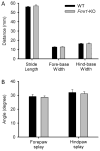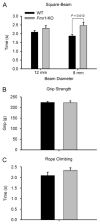Comprehensive motor testing in Fmr1-KO mice exposes temporal defects in oromotor coordination
- PMID: 22004265
- PMCID: PMC4874324
- DOI: 10.1037/a0025920
Comprehensive motor testing in Fmr1-KO mice exposes temporal defects in oromotor coordination
Abstract
Fragile X syndrome (FXS; MIM #300624), a well-recognized form of inherited human mental retardation is caused, in most cases, by a CGG trinucleotide repeat expansion in the 5'-untranslated region of FMR1, resulting in reduced expression of the fragile X mental retardation protein (FMRP). Clinical features include macroorchidism, anxiety, mental retardation, motor coordination, and speech articulation deficits. The Fmr1 knockout (Fmr1-KO) mouse, a mouse model for FXS, has been shown to replicate the macroorchidism, cognitive deficits, and neuroanatomical abnormalities found in human FXS. Here we asked whether Fmr1-KO mice also display appendicular and oromotor deficits comparable to the ataxia and dysarthric speech seen in FXS patients. We employed standard motor tests for balance and appendicular motor coordination, and used a novel long-term fluid-licking assay to investigate oromotor function in Fmr1-KO mice and their wild-type (WT) littermates. Fmr1-KO mice performed equally well as their WT littermates on standard motor tests, with the exception of a raised-beam task. However, Fmr1-KO mice had a significantly slower licking rhythm than their WT littermates. Deficits in rhythmic fluid-licking in Fmr1-KO mice have been linked to cerebellar pathologies. It is believed that balance and motor coordination deficits in FXS patients are caused by cerebellar neurophathologies. The neuronal bases of speech articulation deficits in FXS patients are currently unknown. It is yet to be established whether similar neuronal circuits control rhythmic fluid-licking pattern in mice and speech articulation movement in humans.
PsycINFO Database Record (c) 2011 APA, all rights reserved.
Figures




Similar articles
-
Comprehensive analysis of ultrasonic vocalizations in a mouse model of fragile X syndrome reveals limited, call type specific deficits.PLoS One. 2012;7(9):e44816. doi: 10.1371/journal.pone.0044816. Epub 2012 Sep 11. PLoS One. 2012. PMID: 22984567 Free PMC article.
-
Hyperexcitability in the Olfactory Bulb and Impaired Fine Odor Discrimination in the Fmr1 KO Mouse Model of Fragile X Syndrome.J Neurosci. 2023 Nov 29;43(48):8243-8258. doi: 10.1523/JNEUROSCI.0584-23.2023. J Neurosci. 2023. PMID: 37788940 Free PMC article.
-
Exaggerated behavioral phenotypes in Fmr1/Fxr2 double knockout mice reveal a functional genetic interaction between Fragile X-related proteins.Hum Mol Genet. 2006 Jun 15;15(12):1984-94. doi: 10.1093/hmg/ddl121. Epub 2006 May 4. Hum Mol Genet. 2006. PMID: 16675531
-
Modeling fragile X syndrome in the Fmr1 knockout mouse.Intractable Rare Dis Res. 2014 Nov;3(4):118-33. doi: 10.5582/irdr.2014.01024. Intractable Rare Dis Res. 2014. PMID: 25606362 Free PMC article. Review.
-
Auditory processing in fragile x syndrome.Front Cell Neurosci. 2014 Feb 4;8:19. doi: 10.3389/fncel.2014.00019. eCollection 2014. Front Cell Neurosci. 2014. PMID: 24550778 Free PMC article. Review.
Cited by
-
Systematic mapping of fragile X granules in the mouse brain reveals a potential role for presynaptic FMRP in sensorimotor functions.J Comp Neurol. 2012 Nov 1;520(16):3687-706. doi: 10.1002/cne.23123. J Comp Neurol. 2012. PMID: 22522693 Free PMC article.
-
Opposing phenotypes in mice with Smith-Magenis deletion and Potocki-Lupski duplication syndromes suggest gene dosage effects on fluid consumption behavior.Am J Med Genet A. 2012 Nov;158A(11):2807-14. doi: 10.1002/ajmg.a.35601. Epub 2012 Sep 18. Am J Med Genet A. 2012. PMID: 22991245 Free PMC article.
-
Influence of Gestational Chlorpyrifos Exposure on ASD-like Behaviors in an fmr1-KO Rat Model.Mol Neurobiol. 2022 Sep;59(9):5835-5855. doi: 10.1007/s12035-022-02933-0. Epub 2022 Jul 8. Mol Neurobiol. 2022. PMID: 35802248
-
The neuronal code(s) of the cerebellum.J Neurosci. 2013 Nov 6;33(45):17603-9. doi: 10.1523/JNEUROSCI.2759-13.2013. J Neurosci. 2013. PMID: 24198351 Free PMC article. Review.
-
Decreased home cage movement and oromotor impairments in adult Fmr1-KO mice.Genes Brain Behav. 2017 Jun;16(5):564-573. doi: 10.1111/gbb.12374. Epub 2017 Mar 29. Genes Brain Behav. 2017. PMID: 28218824 Free PMC article.
References
-
- Antar LN, Afroz R, Dictenberg JB, Carroll RC, Bassell GJ. Metabotropic glutamate receptor activation regulates fragile X mental retardation protein and FMR1 mRNA localization differentially in dendrites and at synapses. Journal of Neuroscience. 2004;24:2648–2655. doi: 10.1523/JNEUROSCI.0099-04.2004. - DOI - PMC - PubMed
Publication types
MeSH terms
Substances
Grants and funding
LinkOut - more resources
Full Text Sources
Other Literature Sources
Medical
Molecular Biology Databases
Research Materials

